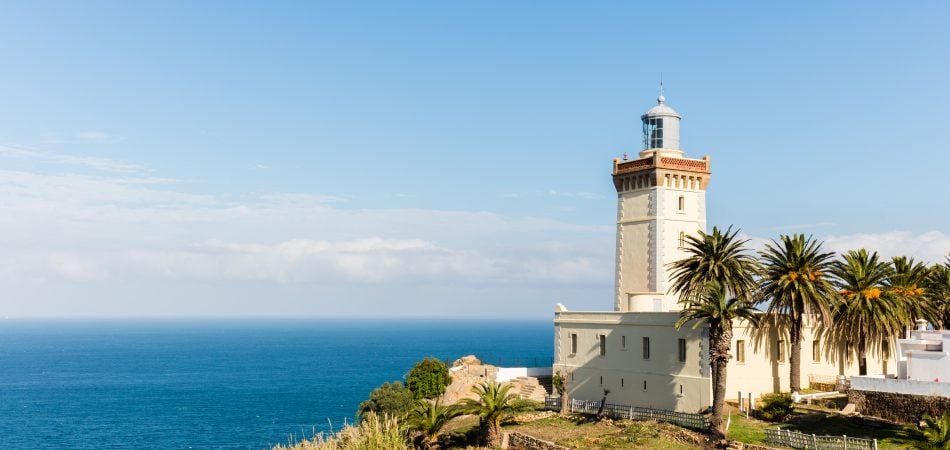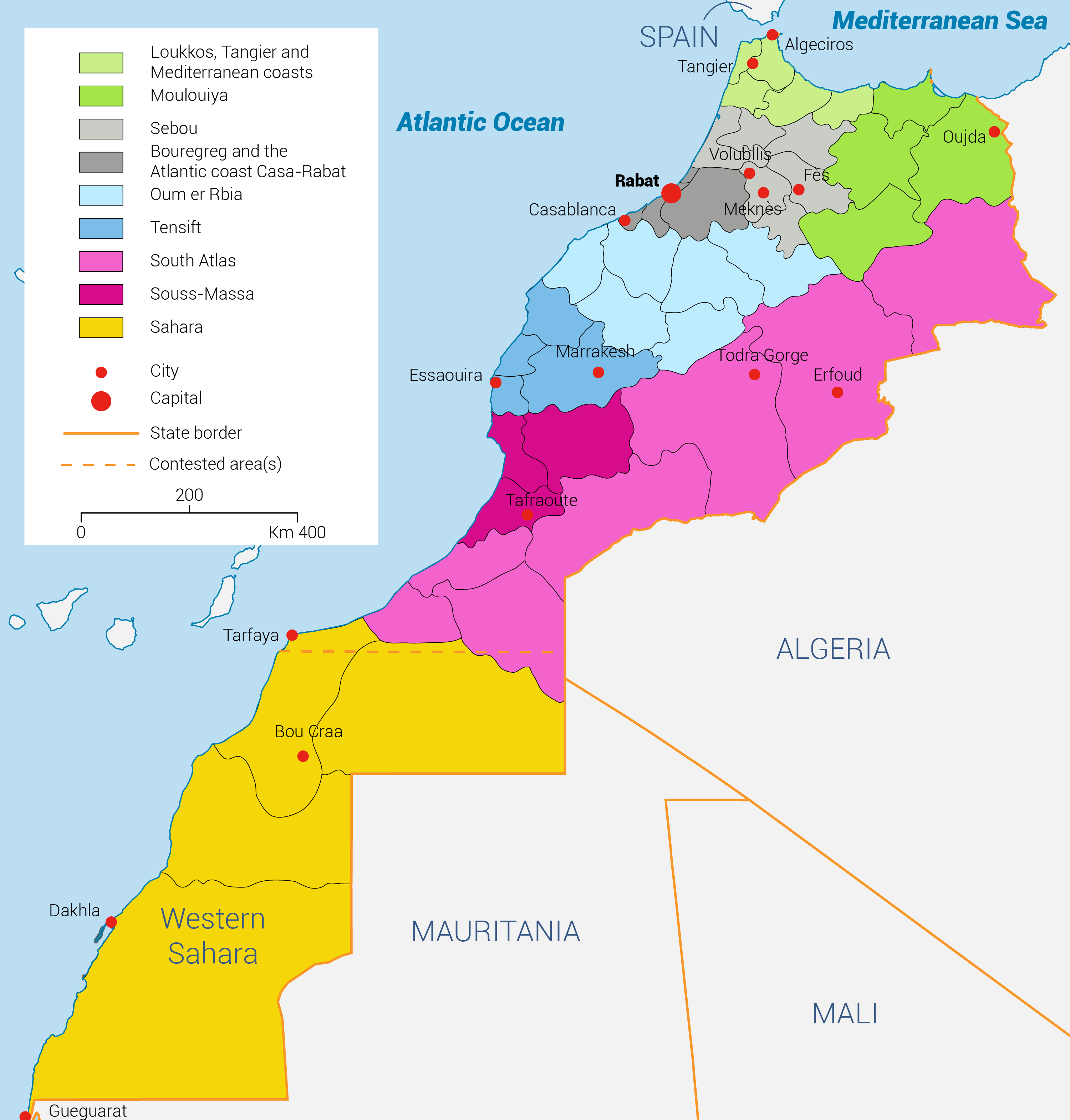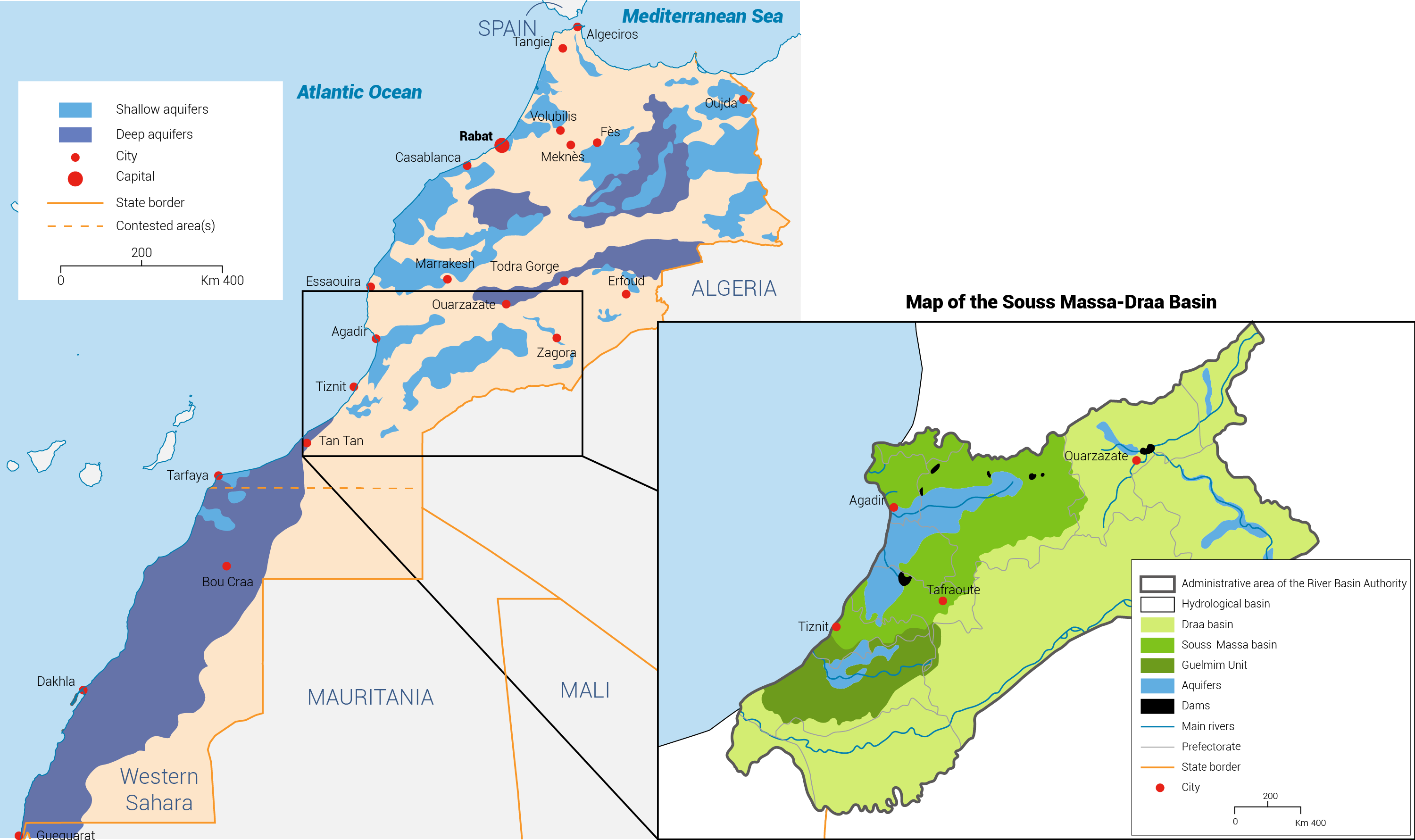
The average rainfall is 140 billion cubic metres per year (BCM/yr), Evapotranspiration is high, amounting to 118 BCM/yr on average. The potential of natural water resources is estimated at 22 BCM/yr, the equivalent of 700 m3/capita/yr, comprising 18 BCM of surface water and 4 BCM of groundwater. The amount of water that is technically and economically exploitable is 80% of current available resources. This reveals the constraints on water resources and the challenges that lie ahead regarding the urgency of an integrated management approach.[1]
Surface water resources
The hydrological regime of all basins is characterized by high inter-annual variability marked by wet and dry sequences, interspersed with years of strong hydraulic flow or severe drought.
The Ouergha basin, for example, is one of the most productive basins in the country, with an average annual inflow of 2.5 BCM. The large regional disparity of rainfall also induces a large variability of surface water flows. The latter varies from a few million cubic metres (MCM) for the most arid basins, such as the Saharan basins, to 1 BCM/yr for the most water-rich basins. For instance, the Sebou basin holds 30% of surface water and groundwater resources. Although it represents only 6% of the total area of Morocco, 18% of the country’s population lives within it.[2] Internal water reallocations are applied to reduce the shortages in each river basin. About 0.3 MCM is transferred from the Oum er-Rbia basin to dry areas in Tensift, essentially to sustain irrigation. Similarly, another 0.16 MCM is transferred from the Sebou and Oum er-Rbia basins to support Bouregreg’s domestic water needs.[3] Map 1 shows the geographical distribution of the hydrological basins. Table 1 shows the nine Moroccan river basins with their area and flow figures.
Table 1: Morocco’s hydrological basins, their area, average flow and exploitable potential. Source: National Water Strategy.
| Name of basin | Area (km2) | Flow (MCM) | Exploitable potential (MCM/year) |
| Loukkos, Tangier and Mediterranean coastal | 12,805 | 3,600 | 190 |
| Moulouya, Figuig-Kert-Isley-Kiss | 76,664 | 1,610 | 512 |
| Sebou | 40,000 | 5,560 | 1300 |
| Bouregreg and Chaouia | 20,470 | 850 | 120 |
| Oum er-Rbia and el-Jadida Safi | 48,070 | 3,315 | 405 |
| Tensift and Ksob-Igouzoulen | 24,800 | 800 | 520 |
| Souss-Massa-Draa | 126,480 | 1,444 | 691 |
| Guir-Ziz-Rhéris | 58,841 | 626 | 313 |
| Sakia el-Hamra and Oued Eddahab | 302,725 | 390 | 16 |
| Total | 710,855 | 18,195 | 4,067 |

The country has 120 major natural lakes, the majority of which are located between the two mountain ranges of the Middle Atlas and High Atlas. On the coast are lagoons and marshes. In 1980, the Ramsar Convention classified four wetlands. Today, the 24 classified sites total 272,010 hectares (ha).[4]
Groundwater resources
Groundwater accounts for about 20% of water resources. The most important aquifers cover a total area of almost 80,000 km², about 10% of the country (Map 2).[5] Total groundwater withdrawals are estimated at 3,170 MCM/yr. However, groundwater has been overexploited, by around 4.2 BCM/yr, 10% higher than the average yearly recharge. This high extraction has led to a rapid drop in the water table, at an average rate of 2 metres per year. The current water level in the Saiss aquifer is 64 metres lower than in the 1980s. Similar drops can be seen in the Souss, Témara, Haouz and South Atlas aquifers. This problem is prone to occur in areas where precipitation is less than 400 mm/yr and groundwater is used for agricultural irrigation by local farmers.[6] Groundwater supplies 40% of the water used for irrigation. The distribution of the exploitable potential of groundwater according to the hydrogeological basins is shown in Table 2.[7]

Non-conventional water resources
Desalination
Seawater desalination is considered a promising non-conventional water source and climate change adaptation measure. In 2009, Morocco launched a National Water Plan (PNE) for 2020-2030, which outlines several measures to address the gap between water supply and demand, including desalination. The PNE proposes the construction of seawater desalination plants to produce nearly 515 MCM/yr in 2030.[8]
By 2016, Morocco had 15 desalination installations, with a total desalination capacity of 132 MCM/yr. Almost all desalination plants (96%) operate with reverse osmosis (RO) systems. The current capacity is relatively evenly split between medium-, large- and extra-large-scale plants. As Morocco imports 95% of its energy, RO will likely remain the preferred technology, given that it is the least energy-intensive of the desalination technologies at large and extra-large scale. However, future desalination projects may be combined with renewable energy generation to address the problem of high-energy costs. The Agadir Desalination Plant is under construction at a cost of about $112 million, using RO technology to produce 36 MCM/yr, to fulfil the drinking water and irrigation needs of 800,000 people (123 litre/capita/day). Two desalination plants at Jorf Lasfar – el-Jadida and Safi, with a capacity of 75 MCM/yr and 25 MCM/yr respectively, are under construction and set to produce 100 MCM/yr of drinking and industrial water by 2025.[9]
Wastewater reuse
The wastewater sector has made significant advances in the last ten years. One of the main issues is wastewater treatment. The National Sanitation Programme aims to connect 80% of the urban population to sanitation networks and to reduce pollution by 60% in 2020. In addition, due to the limited surface water resources and growing demand, most of the groundwater resources have been overexploited. The performance of supply networks and water uses is still low; new tariffs could improve this. More than 120 wastewater treatment plants have been built, increasing the treatment capacity to 900 MCM/yr in 2016. Indicatively, 75% of the total population is connected to the sewer network, with 62% connected to wastewater treatment plants.[10] The PNE targets reuse of 325 MCM/yr of wastewater by 2030.[11]
Despite the high potential, the level of wastewater reuse is low. It is expected that by 2030, wastewater generation will increase to 900 MCM. Of the total wastewater discharge, 60% is discharged directly into the Mediterranean and Atlantic, while 40% is discharged into the natural environment (Figure 1).[12]
Table 2 shows the breakdown of the wastewater reuse projects by basin. The implementation of the National Sanitation Programme and PNE was a real trigger for controlled reuse of wastewater. Eighteen wastewater reuse projects with a total production of 38 MCM are in operation and supplying good-quality water for the following uses:
Figure 1: Wastewater reuse in Morocco in 2016 (MCM/year). Source: Netherlands Enterprise Agency.
- Irrigation of green spaces, parks and golf courses (69.3%);
· Agriculture, which currently accounts for 13%;
· Industry, specifically phosphate mining (16.6%);
· Groundwater recharge (1.1%).[13]
Table 2: Wastewater reuse potential per basin by 2030. Source: Netherlands Enterprise Agency.
| River Basin | Irrigation | Industries | Landscaping / golf courses | Groundwater recharge | Total |
| Loukkos | 20 | - | 7 | - | 27 |
| Moulouya | 12 | - | 9 | - | 21 |
| Sebou | 34 | - | 15 | 10 | 59 |
| Bouregreg | 19 | - | 1 | - | 20 |
| Oum ErRabia | 15 | 16 | 4 | - | 35 |
| Tensift | 1 | 1 | 56 | - | 58 |
| Souss Massa | 38 | - | 40 | 10 | 88 |
| Sud Atlas | 3 | - | 1 | - | 4 |
| Total | 142 | 17 | 133 | 10 | 312 |
Total water availability and per capita availability
Morocco’s water resources are under increasing pressure from population and industrial growth, irrigated agriculture, urbanization, tourism, climate change, the overexploitation of aquifers, the low cost of piped water and deteriorating water quality caused by sanitation shortcomings.[14] Water availability is predicted to drop to 500 m³/capita/year by 2030. In contrast, the demand for water is projected to continue growing, from 14.3 BCM in 2010 to 23.6 BCM in 2030.[15]
[1] United Nations, 2014. Morocco: Environmental Performance Reviews, series no. 38.
[2] Ibid.
[3] Ibid.
[4] FAO AQUASTAT, 2015. Morocco.
[5] Government of Morocco, 2009. National Water Strategy.
[6] United Nations, 2014. Morocco: Environmental Performance Reviews, series no. 38.
[7] Government of Morocco, 2009. National Water Strategy.
[8] Houzir M, Mokass M and Schalatek L, 2016. Climate Governance and the Role of Climate Finance in Morocco.
[9] World Bank, 2017. Managing Urban Water Scarcity in Morocco.
[10] Netherlands Enterprise Agency, 2018. Business Opportunities Report for Reuse of Wastewater in Morocco.
[11] Houzir M, Mokass M and Schalatek L, 2016. Climate Governance and the Role of Climate Finance in Morocco.
[12] Netherlands Enterprise Agency, 2018. Business Opportunities Report for Reuse of Wastewater in Morocco.
[13] Ibid.
[14] Houzir M, Mokass M and Schalatek L, 2016. Climate Governance and the Role of Climate Finance in Morocco.
[15] Ibid.
